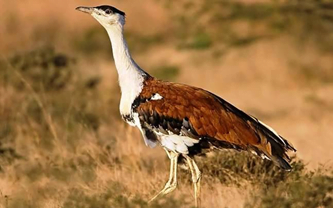Environment & Ecology
Context: Coming to the rescue of the critically endangered Great Indian Bustard (GIB), the Supreme Court recently mooted the idea of launching ‘Project GIB’ on the lines of ‘Project Tiger’, which was started in 1973 to save the big cats, and sought the government’s view on the proposal.
About Great Indian Bustard:

- Common Name: Great Indian bustard
- Scientific Name: Ardeotis nigriceps
- Population: 200 individuals worldwide
- Height: 100 cms or 1 metre
- Length: Wingspan of 210-250 cm
- Weight: 15-18 kg
- Status: Listed in Schedule I of the Indian Wildlife (Protection)Act, 1972, in the CMS Convention and in Appendix I of CITES, as Critically Endangered on the IUCN Red List and the National Wildlife Action Plan (2002-2016).
- It has also been identified as one of the species for the recovery programme under the Integrated Development of Wildlife Habitats of the Ministry of Environment and Forests, Government of India.
Characteristics:
- The body is brownish and the wings are marked with black, brown and grey.
- Males and females generally grow to the same height and weight but males have larger black crowns and a black band across the breast.
- They breed mostly during the monsoon season when females lay a single egg on open ground. Males play no role in the incubation and care of the young, which remain with the mother till the next breeding season.
- Their diet ranges widely depending on the seasonal availability of food. They feed on grass seeds, insects like grasshoppers and beetles, and sometimes even small rodents and reptiles.
HABITAT AND DISTRIBUTION
- Historically, the great Indian bustard was distributed throughout Western India, spanning 11 states, as well as parts of Pakistan.
- Its stronghold was once the Thar desert in the north-west and the Deccan plateau of the peninsula.
- Presently, its population is confined mostly to Rajasthan and Gujarat.
Conservation Issues:
- The biggest threat to this species is hunting, which is still prevalent in Pakistan.
- This is followed by occasional poaching outside Protected Areas, collisions with high tension electric wires, fast moving vehicles and free-ranging dogs in villages.
- Other threats include habitat loss and alteration as a result of widespread agricultural expansion and mechanized farming, infrastructural development such as irrigation, roads, electric poles, as well as mining and industrialization.
World Wildlife Fund (WWF) – India’s Initiatives:
- WWF-India has provided inputs in developing the ‘Guidelines for the State Action Plan for Resident Bustard Recovery Programme’.
- It has played an important role in raising awareness about the declining populations and highlighting the importance of implementing a focused bustard conservation programme at the national level.
- WWF-India, is undertaking initiatives towards conservation of GIB in and around Desert National Park.
Source: Press Trust of India
Previous Year Questions
Q.1) With reference to India’s Desert National Park, which of the following statements are
correct? (2020)
- It is spread over two districts.
- There is no human habitation inside the Park.
- It is one of the natural habitats of the Great Indian Bustard.
Select the correct answer using the code given below:
- 1 and 2 only
- 2 and 3 only
- 1 and 3 only
- 1, 2 and 3












